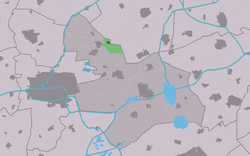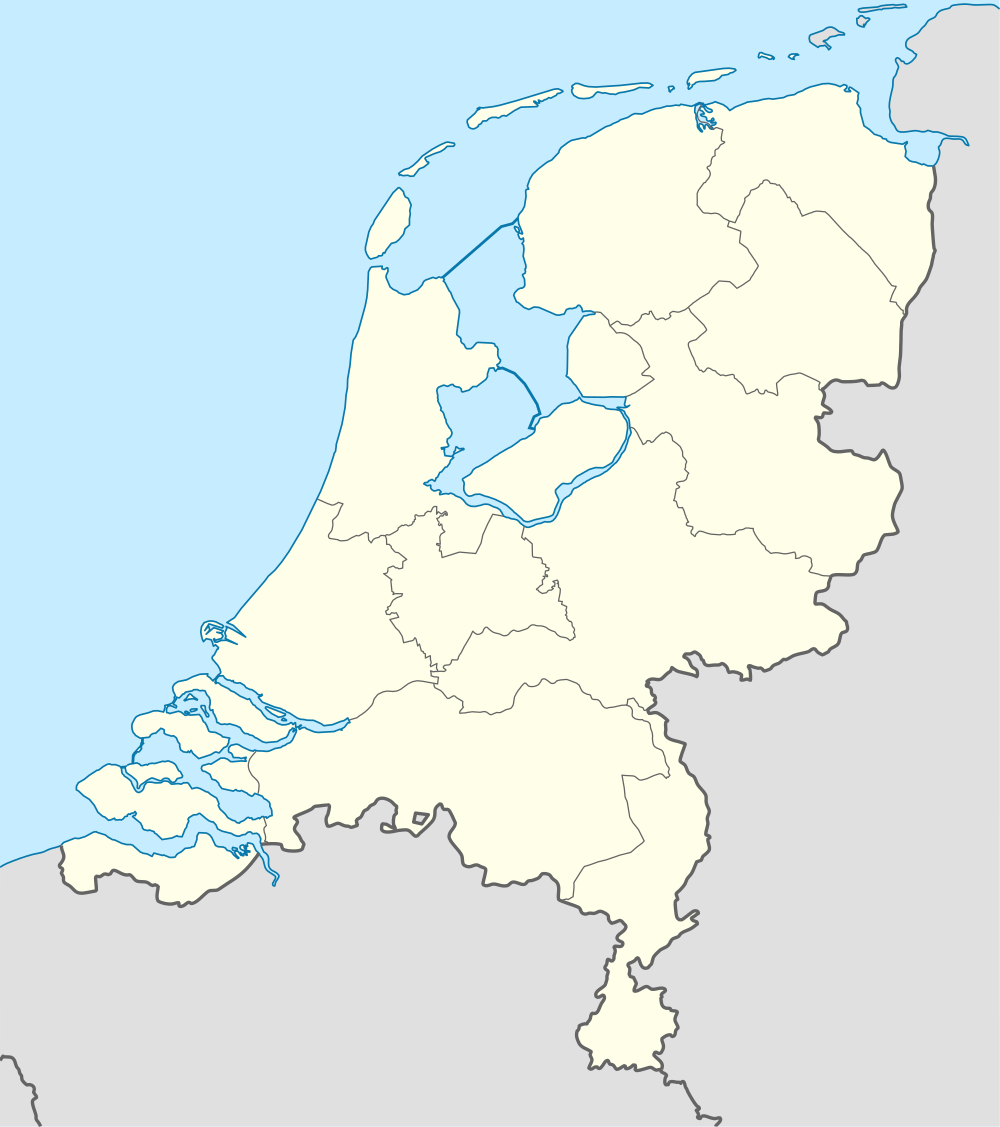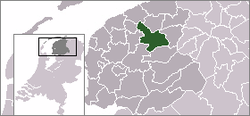Mûnein
Mûnein (Dutch: Molenend[1]) is a small village in Tytsjerksteradiel municipality in the province Friesland of the Netherlands. It had a population of around 580 in 2018.[2]
Mûnein Molenend | |
|---|---|
Village | |
Local farmhouse | |
 Coat of arms | |
 Location of the village in Tytsjerksteradiel | |
 Mûnein Location in the Netherlands | |
| Coordinates: | |
| Country | |
| Province | |
| Municipality | |
| Population (1 January 2017) | |
| • Total | 718 |
| Time zone | UTC+1 (CET) |
| • Summer (DST) | UTC+2 (CEST) |
| Postal code | 9063 |
| Dialing code | 058 |
History
Until 1948 was Mûnein a part of Oentsjerk. At the request of "Dorpsbelang" (Village Interest) Mûnein received village status. Until then, it was customary for village status to be given to areas with a church which Mûnein did not have. But because there is a café, a primary school and several associations, the municipality Tytsjerksteradiel gave village status on October 8, 1948.
Since 1953 Mûnein is officially part of the Trynwalden a region on a sand bar which includes the villages of Oentsjerk. Gytsjerk, Aldtsjerk and Readtsjerk.
Flax factory
It was Baron Theo van Welderen Rengers of Heemstra State, who stimulated the construction of the flax factory. He was a member of the commission Door Arbeid tot Verbetering, which was founded by his father, Julius Wilco. On May 6, 1898, an application was submitted at the municipality Tytsjerksteradiel to build a factory near the Swarte Broek, a lake near Mûnein. Thus the first factory of the "N.V. Friesche Maatschappij van Vlasindustrie" was built in Mûnein. The name can be seen in colorful tiles on the roof and on the front of the factory. The location of the Swarte Broek was chosen because the flax had to first go through a rotting process in the open waters. The opening of the factory took place on November 24, 1898 with J.J. Westra as director. The plant was closed on 24 April 1967. The restored smokestack and a statue on the square in town still refer to the time of the flax processing. Today there is a facility for the mentally handicapped in the old flax factory and by the tall smokestack still be seen from afar.
Siamese twins
Mûnein became national news in 1953 at the birth of Siamese twins on November 8, 1953. Village Doctor Wijthoff told the mother that her seventh child was on the way but she gave birth to two babies joined at the stomach. They were rushed by taxi to the Diakonessenhuis, a hospital in Leeuwarden charged. The babies were well and examination revealed they had their own hearts, lungs and other organs. They were physically independent of each other. It was discussed with an English physician who had experience with a separation of Siamese twins. Seven months after birth, in 1954 the twins underwent surgery to separate them. They were the first Siamese twins in the Netherlands to have a successful separation.
Community
Population
- 1954 - 791
- 1969 - 775
- 1964 - 731
- 1969 - 666
- 1974 - 638
- 2006 - 701
Famous (former) residents of Mûnein
- Lieuwe Westra (September 11, 1982) - cyclist
Streets
- Doctor Kijlstrawei - 1860 -1910 doctor who had a medical practice Uniastate and then was succeeded by his son.
- Earn Buorren - the description of the meaning of this name is missing from the file. This piece description should have been but a part of the letter of Master Sannes the name is apparently lost. Sannes has been postponed in 1949.
- Flaaksikkers- referring to the former flasfabriek.
- Flokhernepaad- This is the name of the region, where once the people were sent there, where the residents of Oentsjerk / Mûnein were embarrassed. Herne is old Frisian corner. You could also say "the cursed corner".
- Halligenwei- Halich in old country name. Fan traditionally in the name of the area south of Mûnein. The Little Halligen: field and countryside just south of Mûnein, the Great Halligen, the field between Mûnein and The Drive.
- Jelte Binneswei - Jelte Binnes Oosterhof
- K Rienewerfstrjitte - Klaas Rien Yard killed in the first May days of 1940 on the Ofslútdyk as a war victim. He is buried in the burial place of Oentsjerk.
- Kaetsjemuoiwei - The street names in 1949 wanted to give this name because it Kaetsjemuoibos, the so-called Kaetsjemuoipad Kaetsjemuoiland and near the street were. The name of the road, Kaetsjemuoiwei was very old and fully established. The Kaetsjemuoi bosk's behind Staniastate in eastern Oentsjerk. Issue in the folk Kaetsjemuoi hot mouth is not known. Possible was renamed as the St. Catherine (or Kaetsje Tryntsje) then the beskerm saint of this area.
- Mûnewei- to the former mill where Mûnein is named Mûne is Frisian for mill.
- Ottemawei- Nanne Ottema
- Aukje Wijbengastrjitte- Aukje Wijbenga wrote two books on Mûnein Tsjerk and Read.
References
- Taalunie (2019). "Friese namen" (in Dutch). Retrieved 18 November 2019.
- Overzicht inwonersaantal Tytsjerksteradiel - Tytsjerksteradiel
